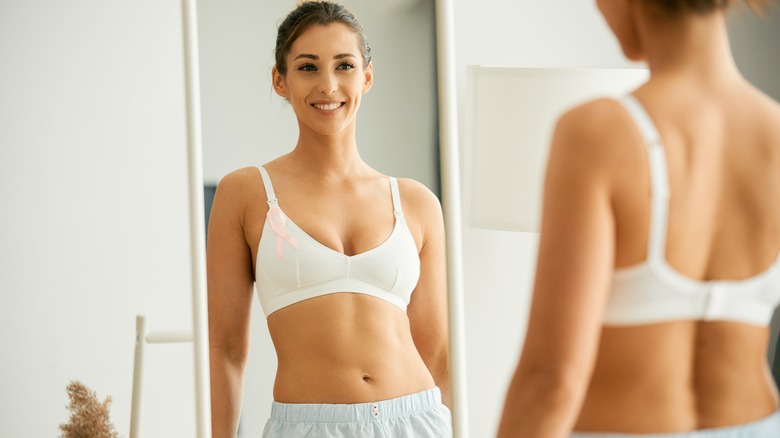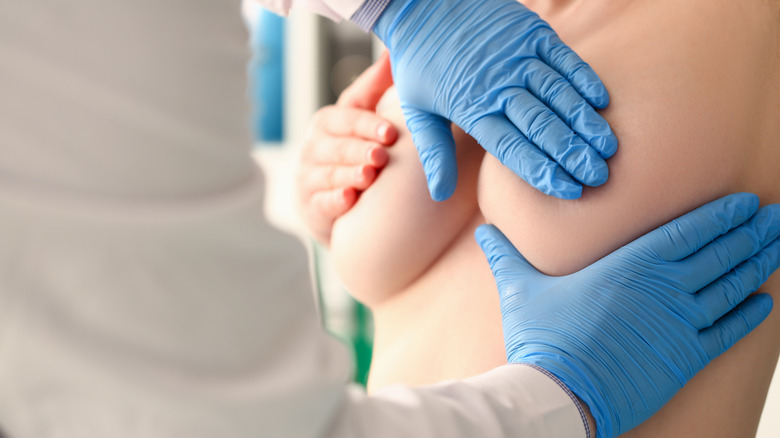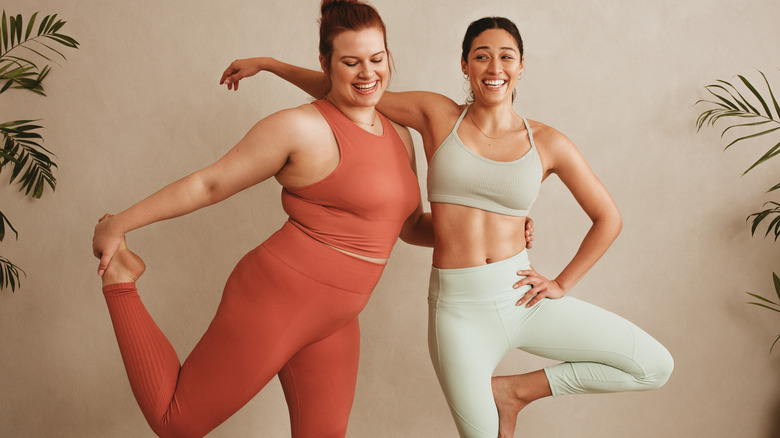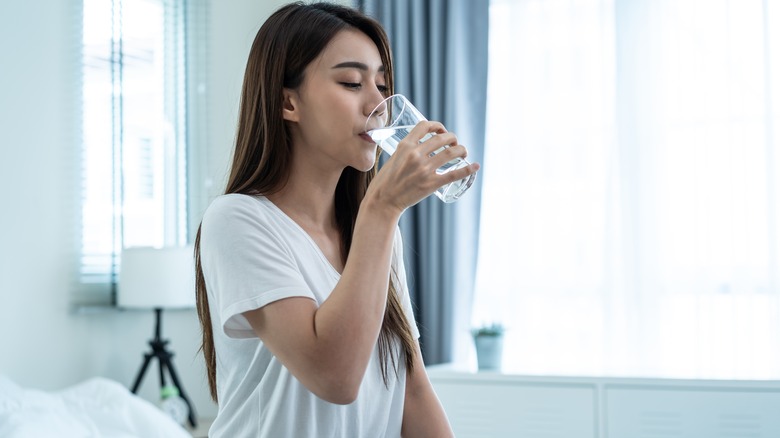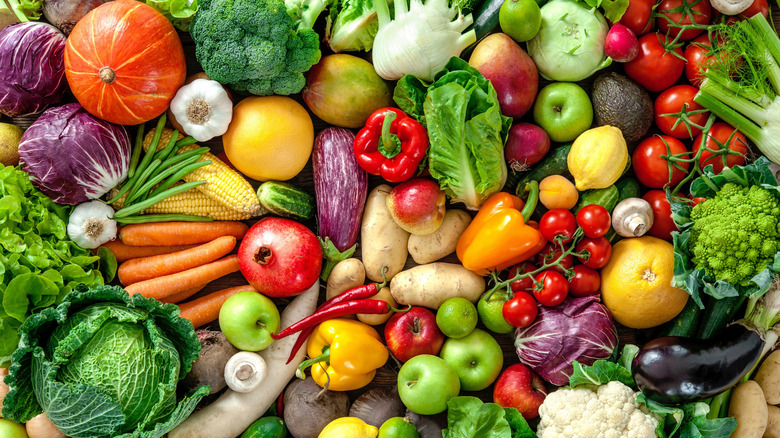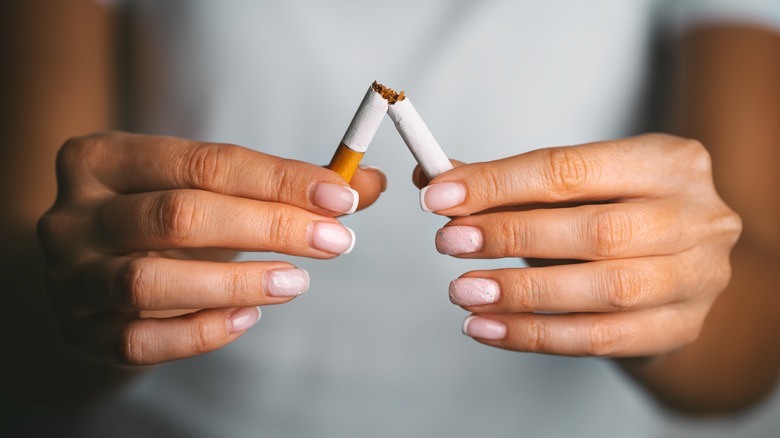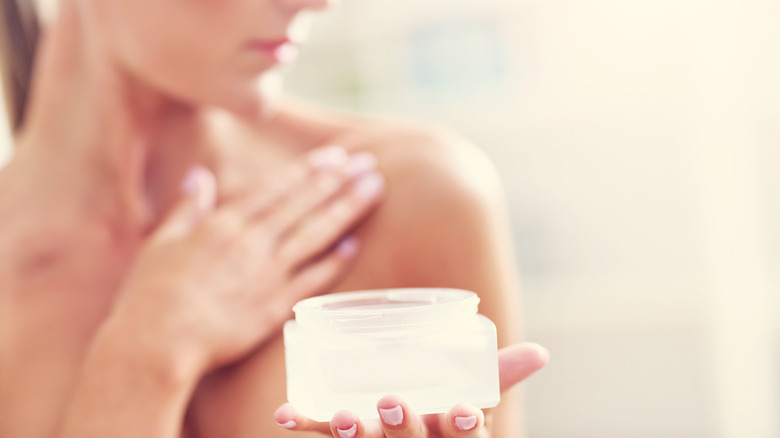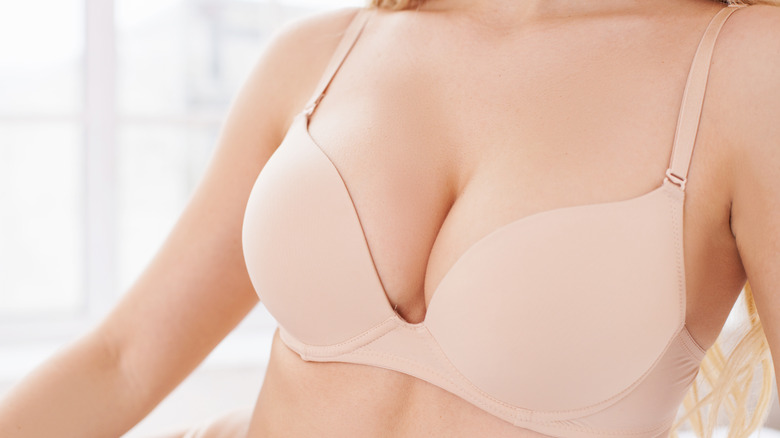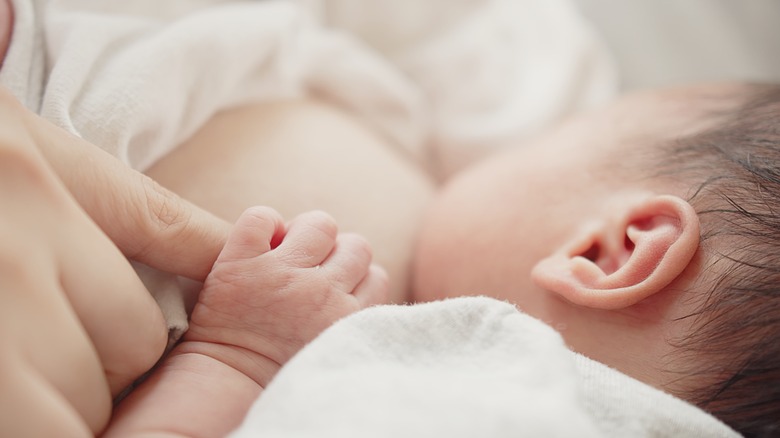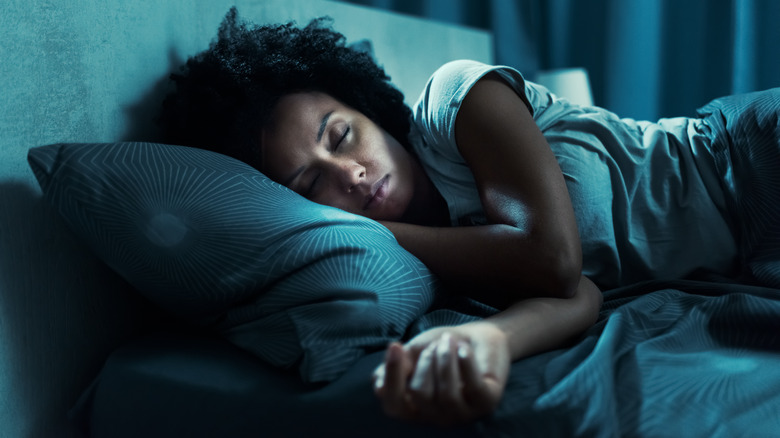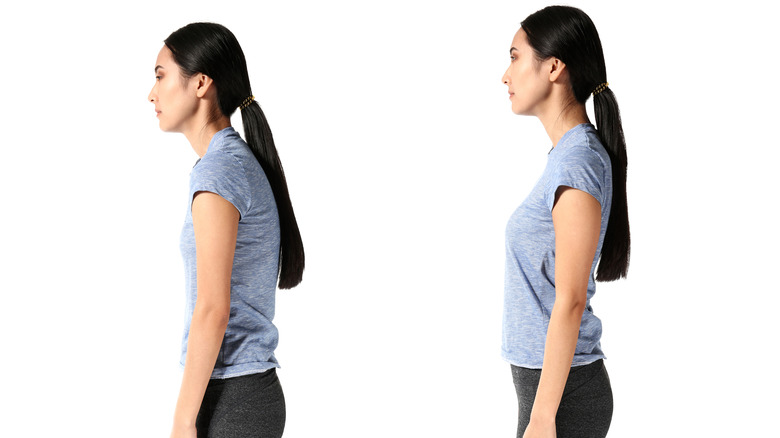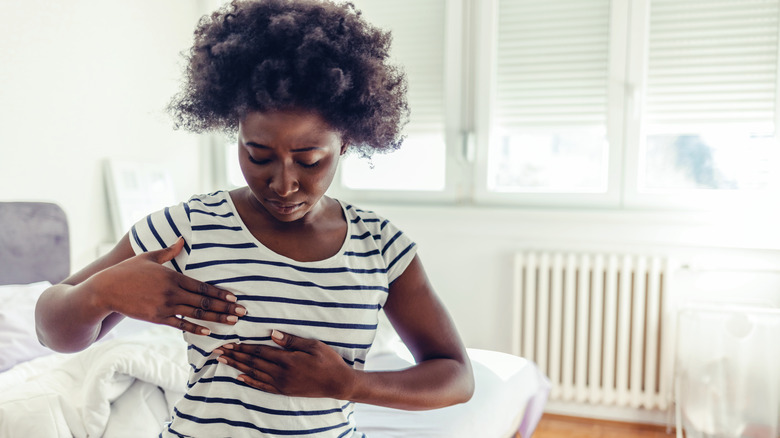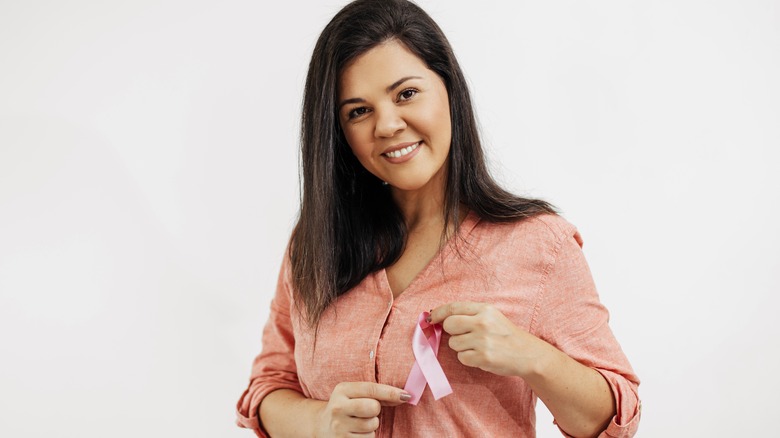14 Tips For Maintaining Breast Health
Breasts are something we all have (yes, men have breasts too). The breasts of men and women are almost the same, save for the structures that make women produce milk. Many women want to have healthy breasts and avoid disorders like breast cancer. Worldwide, breast cancer is the most common cancer that affects women. Statistics in the U.S. show that women have a 1 in 8 chance of getting breast cancer in their lifetime. Breast cancers have their signs, but most symptoms that show up in the breast — like masses and lumps — have benign (non-cancerous) causes like mastitis, fibroadenoma (a benign tumor), cysts, or fibrocystic changes (via Medicine Net).
There are things you can do to protect and maintain your breast health. These involve watching out for unusual changes, avoiding behaviors that put you at risk of breast disorders like cancer, and taking proactive measures to safeguard your breasts.
Practice breast self-awareness
According to the Mayo Clinic, the first step in managing your breast health is breast awareness. Simply, breast awareness is knowing your breasts — how they look, how they feel to touch, how sensitive they are, and how they change during your menstrual cycle, as you age, or due to other factors. This helps you detect any abnormal changes. You may be familiar with monthly breast self-exams, but medical experts no longer recommend that you do these, notes Rochester Regional Health. Evidence shows that they don't help much in the detection of breast cancer and they can contribute to false-positive test results.
If you're used to breast self exams, there's no need to quit, says breast oncology specialist and nurse practitioner R. Morgan Steele to MultiCare Vitals. Just don't squeeze the nipples and cause needless harm. Moreover, any discharge from forceful squeezing is likely not a cause for worry. It's discharge that comes without squeezing that's concerning, says Steele. It's enough to observe breasts' shape, size, and skin characteristics in the mirror and know how your breasts feel. You should let your physician know about changes in breast size or shape, breast skin discoloration, dimpling, thickening, or warmth, nipple flattening, discharge, sores or rashes, a new pain, or an unusual lump. You shouldn't panic if you discover that your breasts are lumpy and bumpy. This is common and it intensifies one to two weeks prior to your period.
Get your clinical breast exam
A clinical breast exam is different from breast self-exams or breast self-awareness. The National Breast Cancer Foundation notes that even though most women discover abnormal breast symptoms themselves, clinical breast exams are thorough and more professional. They help catch breast abnormalities so appropriate measures can be taken.
During your exam, your doctor will observe your breasts' shape and size with your hands raised, by your sides, or at your hips. Your breast skin and nipples will be assessed as well. Your doctor will also palpate your breasts to assess your lymph nodes and to find any abnormal lumps.
Per this guideline by the National Comprehensive Cancer Network, there can be different interpretations of breast symptoms you find yourself or during a clinical breast exam. However, most symptoms have benign causes. If any abnormalities are found, your doctor may request further tests like mammograms, breast MRI (magnetic resonance imaging), breast ultrasonography, and breast tissue biopsy.
Exercise and maintain a healthy weight
Being overweight or obese increases your risk of breast cancer as well as other conditions. Increased estrogen and insulin levels play roles in the development of breast cancer, and these hormones reach high levels when you have excess fat in your body (via the American Cancer Society). But the relationship between a person's weight and risk of breast cancer is more complex than that. For example, this risk may not be high for women who have been overweight since childhood, but is high for women who gained weight in adulthood. Also, breast cancer risk is higher if excess body fat is situated around the waist than around your hips or thighs. More research is still needed to fully under how weight affects breast cancer risk.
Exercising and being physically active can help you manage your weight and reduce your risk of breast cancer (via Mana Medical Associates). Additionally, physical activity lowers estrogen levels and boosts immunity, which helps destroy or delay the growth of cancer cells. These effects depend on how much activity you get. That's why 150 minutes of moderate activity or 75 minutes of vigorous activity is recommended each week (via the World Health Organization). Even if you can't meet these recommendations, increasing your level of physical activity still goes a long way.
Drink lots of water
Many lifestyle habits can increase your risk for breast cancer, and drinking less water may be one of them. This study published in the International Journal of Environmental Research and Public Health found that after adjusting for other risk factors, women recently diagnosed with breast cancer drank 20.2% less water and 14% less total fluids than women without breast cancer. Drinking less water can cause delayed digestion and, consequently, constipation. The researchers explain that chronic constipation may lead to breast cancer because it prevents the passing of excess estrogen and other carcinogens through feces. Therefore, these substances remain in the blood and can participate in the development of breast cancer.
The total amount of fluid women need is about 2.7 liters per day, while men need 3.7 liters, per the Mayo Clinic. The body gets 80% of the total fluid it needs from fluids you drink (water and beverages). And the remaining water is gotten from solid food. Water intake is important every day because the body loses water through sweat and urine. And you need even more water if you sweat a lot from physical activity or if the weather is hot.
Improve your diet
Healthline notes that incorporating certain foods into your diets can help reduce your breast cancer risk. If you need a diet compass, loading up on fruits and vegetables is the right way to go. Also, whole grains, fatty fish, herbs and spices, walnuts, beans, and fermented foods help guard against breast cancer.
Citrus fruits (oranges, lemons, grapefruits) contain folate, vitamin C, carotenoids, and flavonoids, which give them antioxidant, anti-inflammatory, and anticancer powers. Berries, peaches, apples, pears, and grapes also protect against breast cancer. As for vegetables, green leafy vegetables (spinach, chard, arugula) are good because they contain carotenoid antioxidants that help stave off breast cancer. Cruciferous vegetables like cabbage, cauliflower, and broccoli prevent breast cancer because they contain glucosinolate compounds, which are converted to potent anticancer molecules known as isothiocyanates within the body. Another group of vegetables with strong anticancer properties are the allium vegetables (garlic, onions, leeks). They contain isoflavonoid antioxidants and vitamin C.
Elevating your diet is one side of the coin. You also need to reduce or eliminate harmful dietary habits like eating fast foods, processed meats, fried foods, added sugars, and refined carbohydrates, as they may increase your breast cancer risk.
Cut out alcohol
Drinking alcohol increases your risk of breast cancer. Estrogen and other hormones implicated in the development of breast cancer increase with alcohol intake, explains Medical News Today. Also, alcohol interferes with the absorption of folate as well as other nutrients. Low folate levels have been associated with increased risk of breast cancer. Alcohol, through its conversion to acetaldehyde or through oxidative stress, causes DNA damage that is associated with cancer formation. As contributing effects, alcohol increases your risk of obesity by increasing your caloric intake, and having alcohol in your system makes it hard for your body to get rid of harmful substances like tobacco.
Alcohol encourages the development of cancers because it contains ethanol. Although stronger drinks have more ethanol content, large quantities of light drinks end up matching the load. Moderate and heavy drinkers have higher breast cancer risks than light drinkers, but the risk is still present for light drinkers. So, it's best to cut out alcohol intake completely. But if you can't, limit your alcohol intake to one drink per day if you are female and two per day if you are male.
Quit smoking
Smoking is known to cause cancers of different parts of the body — lungs, mouth, throat, bladder, liver, cervix amongst others. And per this study, published in Breast Cancer Research, it increases breast cancer risk in certain groups of women. Among smokers, increased breast cancer risk was found among women with a family member with breast cancer, women who smoke more than five cigarettes per day, women with more than ten "pack years" (number of packs smoked per day multiplied by the number of years spent smoking, via the National Cancer Institute), women who have smoked for more than ten years, and women who stopped smoking within the past 20 years. The age when a woman starts smoking also factors into breast cancer risk. Increased risk of breast cancer was found among females who started smoking before 17 years, around the time of their first period, or when breasts started developing.
How smoking causes breast cancer still requires further studies. However, this study shows that long-term smoking, smoking during adolescence (when the body and breasts are developing), or smoking when one has breast cancer gene mutations or family history may increase breast cancer risk. And these can serve as focus areas for future research.
Take care of the skin around your breasts
You have thin and delicate skin around your breast, nipple, and other parts of your chest (via Women's Health). This skin can easily get dry, red, inflamed, and chafed, so a moisturizer that helps prevent these can be beneficial. The skin around this area is usually among the first to show signs of aging, notes Simona Valev, cofounder of Rawkanvas, to the site. So it's important to use sweeping motions to apply your lotion around this area and up the neck, advises Valev. When choosing a product, you can look out for ingredients that are good for the skin like hyaluronic acid, cocoa butter, shea butter, and antioxidants like polyphenol and resveratrol. But you should avoid harsh soaps, retinols, and products with drying alcohols, because these can dry out your skin. Petroleum-based products are usually thick and can block your Montgomery glands, leading to breast pimples.
There has been concern that some cosmetic products may contain carcinogenic chemicals or endocrine disruptive chemicals. From available research, it still remains unclear whether these chemicals can cause cancers in humans, notes the American Cancer Society. If you're concerned about any personal care product, you can look it up on the Environmental Working Group's database to find out if they contain any harmful substances even if they are left off the product label.
Wear well-fitting bras
Some women wear bras because of the support they provide, while some women don't enjoy the confines. Whether you choose to wear a bra or not does not increase or decrease your breast cancer risk (via Medical News Today). So you don't have to go braless if it makes you uncomfortable. Wearing a properly fitting bra doesn't affect your health, although wearing a bra to sleep might affect your sleep quality by increasing your core body temperature and decreasing melatonin. However, wearing a badly fitting bra can lead to pain in the neck, back, or chest, as well as formation of shoulder grooves.
Many women choose not to wear bras, which isn't bad. But exercising without a bra can be uncomfortable ... and you need to exercise. The right sports bra supports your breasts when you move, prevents them from swinging (saving you from embarrassment), and prevents breast pain, especially if your breasts are large.
Care for your breasts during pregnancy and while breastfeeding
Breast care is important during pregnancy and after childbirth, as this is a time of breast changes like enlargement and milk leakage. You should use breast pads to soak up leaked milk and change wet or sweaty bras. To prevent nipple dryness or irritation, you can use moisturizing creams, nipple protectors, and avoid harsh soaps. Massaging the breast with coconut or olive oil can help with nipple dryness and improve blood circulation. Also, keep an eye out for unusual breast changes and report them to your physician (via Parenting First Cry).
Caring for the breast should continue during breastfeeding. Some women experience nipple pain when they breastfeed. Nipple pain may be because your baby isn't latched properly, notes Better Health Channel. If nipple pain doesn't go away with correct attachment or happens even when you're not breastfeeding, you should let your physician know, as it could be a sign of thrush (a fungal infection), bacterial infection, nipple eczema, or nipple dermatitis. It's also best to avoid nipple ointments, powders, or tinctures, as they aggravate nipple problems. Mastitis is another problem common to breastfeeding mothers. It can be avoided by feeding your baby regularly and on time, ensuring that the baby latches properly, and avoiding excess pressure to the breast from tight bras, seat belts, poor sleeping position, or squeezing the breast while breastfeeding.
Check your sleep habits
We spend about a third of our lives asleep, and this has effects on health and diseases (via Scientific American). The relationship between sleep and cancer has caught the interest of many scientists, and research within this area is budding, notes the Sleep Foundation. Short sleep duration, poor sleep quality, circadian rhythm disturbances, and certain sleep disorders have been associated with increased risks of different cancers. Sleep influences cell activities, the immune system, as well as different processes within the body, which could explain why bad sleep could take part in causing cancers. Also, sleep problems are known to lead to other conditions like obesity that are linked with cancer.
One study published in the International Journal of Cancer found associations between breast cancer and difficulty sleeping or sleeping with artificial lights. Sleeping with artificial lights reduces levels of the hormone melatonin (which is usually highest at night). Amongst other functions, melatonin suppresses estrogen circulation in the body. So, the body could be exposed more to estrogen and an increased breast cancer risk due to artificial lights. A meta-analysis published in Biomed Research International found that compared to women with normal sleep durations (six to seven hours) women who sleep longer have increased breast cancer risk. Melatonin levels reduce when you get too much sleep. Also, longer sleep increases inflammation and cortisol levels, and reduces levels of natural killer cells (a class of immune cells), and these effects are associated with cancers.
Always maintain good posture
Maintaining good posture when standing, sitting, or lying down has merits. It prevents back or neck pain, ensures proper back support and good spine health, aids digestion, relieves stress on your joints, and can boost your mood. It involves aligning your body properly and holding yourself against gravity without straining supporting structures like muscles and bones (via Barrington Orthopedic Specialists).
Your breasts, being on your torso, are affected by your posture. Standing or sitting with your shoulders squared rather than being hunched all the time elevates your breasts and makes them appear fuller. Healthline notes that hunching can contribute to breast sagging. If your back is always hunched, your breasts can be pulled down by gravity. Poor posture, however, is not the sole cause of breast sagging, as breast sagging happens as women age and is influenced by factors like gravity, breast size, weight fluctuation, and multiple pregnancies.
Your breasts can benefit from a good massage
Like massages given to any other body part, breast massages can be relaxing, notes Flo Health. Pectoral muscles under your breasts also need tension relief, as they help with lifting heavy stuff and maintaining your posture. Massaging the breasts improves lymph flow and relieves pain from stagnant lymph. You also become breast aware when you regularly massage your breasts. Breastfeeding mothers can improve blood flow, reduce breast sensitivity, and increase milk supply with breast massages. Nipple massage can also help remedy flat nipples, enabling the baby to latch properly.
Breast massages are simple to perform, so you don't need someone else to do it for you. There are no strict rules for massaging your breasts. However, gentle pressure, circular movements, and smooth strokes are great ways to massage any part of your body, including your breast. You may need professional aid if you have breast cancer, and you can get tips from a lactation specialist if you need to improve breastfeeding.
Know your breast cancer risk
Your breast cancer risk is the compilation of factors that contribute to your likelihood of developing breast cancer, notes the American Cancer Society. Having one or many risks doesn't sentence you to breast cancer, but knowing your risk can help you be proactive with your breast health.
You can't control some breast cancer risk factors, and a major one is being genetically female. Breast cancer is common among women, especially women above 55 years. It's also found more among women who are tall, have dense breast tissues, start their periods early (before 12 years), enter menopause late (after 55), have an immediate family member with breast cancer, or have had cancer in one breast. Inherited BReast CAncer gene mutations (BRCA1 and BRCA2) or some other mutations increase breast cancer risk. Women with BRCA mutations have a 70% chance of getting breast cancer before they turn 80.
There are risk factors that are within your control and you can avoid, such as obesity, alcohol use, and physical inactivity. Also, women have a slightly reduced breast cancer risk if they breastfeed, give birth many times, and start giving birth before they turn 30. Using certain birth control pills, getting breast implants, or getting menopausal hormone therapy may increase your breast cancer risk, so you should clarify with your doctor should you need these therapies (via the American Cancer Society).


